
The Eulophidae is a large family of hymenopteran insects, with over 4,300 described species in some 300 genera. The family includes the genus Elasmus, which used to be treated as a separate family, "Elasmidae", and is now treated as a subfamily of Eulophidae. These minute insects are challenging to study, as they deteriorate rapidly after death unless extreme care is taken, making identification of most museum specimens difficult. The larvae of very few species feed on plants, but the majority are primary parasitoids on a huge range of arthropods at all stages of development. They are exceptional in that they are one of two hymenopteran families with some species that are known to parasitize thrips. Eulophids are found throughout the world in virtually all habitats.

Aprostocetus is a genus of hymenopteran insects of the family Eulophidae. The genus was erected by John O. Westwood in 1833. This very large group of parasitoid wasps has a global distribution.

Aleochara is a genus in the beetle family Staphylinidae, the rove beetles. Larvae of Staphylinidae occur in many assorted ecological roles, most being scavengers, predators or carrion feeders, but the larvae of at least those species of Aleochara whose life histories are known are parasitoids. They feed in the puparia of suitable species of flies, killing the host in the process. Adult Aleochara are predators.

The Cheloninae are a cosmopolitan subfamily of braconid parasitoid wasps.

The Doryctinae or doryctine wasps are a large subfamily of parasitoid wasps within the family Braconidae.

Cystomastacoides is a genus of parasitoid wasps belonging to the family Braconidae. It was named by Dutch entomologist Kees van Achterberg in 1997 from a single species Cystomastacoides coxalis discovered in Yunnan, China. There are only four species described in the genus, the other three having been reported on 19 March 2013. As typical ichneumon wasps, they are characterised by a deadly parasitoid behaviour. Their larvae grow inside the body of other insects, such as caterpillars, and feed on their internal organs inside the body until they emerge.

Phoracantha semipunctata, the Australian Eucalyptus longhorn, is a species of beetle in the family Cerambycidae. Native to Australia, it has now spread to many parts of the world, including practically all countries where tree species of Eucalyptus have been introduced. It has been classified as an invasive pest species of Eucalyptus outside Australia.

Bracon is a genus of wasps in the Braconidae, a family of parasitoid wasps. There are several hundred described species but there are thousands still undescribed. The genus is cosmopolitan, distributed throughout the world, with most of the described species occurring in the Palearctic realm.

Spathius is a genus of doryctine wasps. The larvae of this genus of wasps feed on beetle larvae. They act as biological controllers of the certain pest beetles, such as Hylurgopinus rufipes and the emerald ash borer.

Cymodusa is a genus of parasitoid wasps in the family Ichneumonidae.

The Rogadinae are a large subfamily of braconid parasitoid wasps. Several Rogadinae species parasitize pest caterpillars and are important for naturally occurring biological control.

Aulacus is a genus of aulacids, ensigns, and gasteruptiids in the family Aulacidae. There are 77 species of Aulacus.

Metopius is a cosmopolitan genus of parasitoid ichneumon wasps in the subfamily Metopiinae. They lay eggs inside caterpillars of Lepidoptera that are found in leaf rolls, and the adult wasps later emerge from the pupa. They are black and yellow striped and reach over 2 cm (0.79 in) in length. Their coloring may be mimicking potter wasps. Metopius spp. make a buzzing noise when captured.
Miropotes is a genus of braconid wasps in the family Braconidae. There are about 15 described species in Miropotes, found in Australasia and southeast Asia.

Evania is a genus of ensign wasps in the family Evaniidae. Like all members of the family, they are cockroach egg parasitoids. There are more than 60 described species in Evania. Evania appendigaster, the blue-eyed ensign wasp, is a common wasp found through most of the world.

Dusona is a genus of parasitoid wasps belonging to the family Ichneumonidae. It is the most species rich genus of the subfamily Campopleginae with 442 known species.

Netelia producta is a species of ichneumonid wasp in the subfamily Tryphoninae found in Australia.
Betylobraconini is a tribe of parasitoid wasp in the family Braconidae. It is represented across Australasia. It is the sister tribe to Gondwanocentrini.
Rogadini is a tribe of parasitoid wasp in the family Braconidae. It is represented in the entire world. It is the largest tribe within the subfamily Rogadinae with 40 extant genera. It is also considered to be the most basal tribe in the subfamily.
















